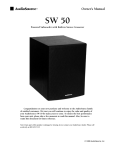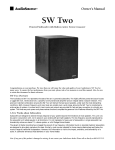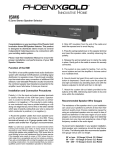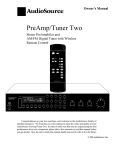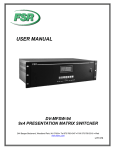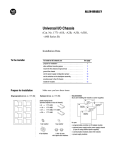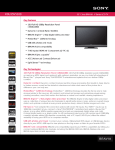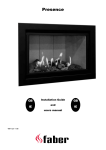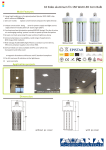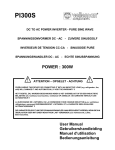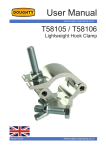Download PSW100 Powered Subwoofer User Manual
Transcript
PSW100 Powered Subwoofer With Active Crossover User Manual Congratulations on your purchase. We trust that you will enjoy the value and quality of your AudioSource PSW100 for many years. Please take a few moments to read this manual, and retain it for your reference. PSW100 Overview The AudioSource PSW100 represents the very latest in affordable state of the art in subwoofer design. The highly efficient ported enclosure houses a rugged ten-inch, mica filled polypropylene driver, a powerful one hundred watt amplifier and an integral crossover network. This precision matched combination ensures the PSW100 will deliver the best sound possible, under the most demanding conditions. Both crossover frequency and input level are variable over a wide range, allowing the PSW100 to compliment a wide variety of loudspeaker systems. Line level and speaker level inputs and speaker level outputs are provided for fast and easy connection to virtually any system. What You Need to Know About Subwoofers Subwoofers are designed to extend the bass response of your system beyond the limitations of most speakers. This subwoofer is to be used in conjunction with, not in place of, your existing speakers. The low frequency sounds reproduced by the subwoofer will radiate equally in all directions. It is not necessary to have a pair of subwoofers, as the frequencies reproduced by a subwoofer are generally non-directional and are not easily located by the human ear. A single subwoofer can dramatically enhance a stereo TV, a stereo system, or a full-fledged home theater. The advent of digital recording has increased the amount of low frequency information found on recorded materials. Subwoofers are designed to accurately reproduce the bass. Similarly, most movies intended for home viewing feature bass response well below the musical range of traditional loudspeakers. However, this information is vital to the impact, ambiance and believability of a scene. A subwoofer enhances those elements in your home theater. Placement Guidelines Prior to installing your new subwoofer, please consider the following guidelines. Placing the subwoofer near a wall or in a corner will greatly increase the level of the information reproduced by the subwoofer. If you should find the low frequency information to be excessive move the subwoofer farther away from a boundary area like the wall or a corner. Conversely, if the low frequency seems thin or non-existent try moving the subwoofer closer to a boundary area like the wall or corner. Because low frequency waves are long and need a great deal of space to be fully reproduced, reflections of these long waves can set-up nodes of peak output and cancellation alternately. If your listening position falls into an area of cancellation, try adjusting the placement of your subwoofer to overcome this problem, and create a peak at your listening position. As you slowly move from one end of the room to ward the other, these areas of peak and null performance will become evident. The subwoofer cabinet is designed to blend in with most decors. If you decide to place anything directly atop your subwoofer, please use great caution, as the speaker cabinet will vibrate and items placed on top may shake loose or fall. Using the Controls Power Switch The Power Switch allows the PSW100 to be turned off when there are no plans to use it over an extended period. Level Since your subwoofer is designed to work in conjunction with other speakers, we have provided a Level control that will allow you to balance the output of your subwoofer with the rest of your system. Once set, the level control should not require further adjustment. Begin with the level control at the minimum position. Slowly increase the level until the subwoofer’s output is equal to that of your other speakers and blends in volume seamlessly. NOTE: Output Level is relative and can be different from location to location. Always return to the normal listening location to evaluate any setting changes. Crossover Frequency The Crossover Frequency control is used to adjust the point at which the subwoofer stops reproducing frequencies played by the other speakers in your system. Raising the crossover frequency increases the frequencies the PSW100 will reproduce. Lowering the crossover frequency will do the opposite. Generally, the smaller the speakers used with the PSW100, the higher the crossover frequency should be set. We recommend starting at the 12 o’clock position, approximately 100Hz and moving to the left with larger speakers, and move to the right with smaller speakers. Connecting The PSW100 The following diagrams illustrate four of the most common types of subwoofer connections. This information will guide you through the connection process. All signals that are input into your PSW100 will first pass through the crossover. The subwoofer will reproduce the portion of the signal below the crossover frequency setting. The full, unprocessed speaker level signal will be pass to the speaker level outputs. If you have a choice of connection options, remember that it may be less expensive and more convenient to run long distances with speaker wire than with line level interconnects. Speaker Level Input These inputs are designed to accept an amplified signal from the speaker outputs of a receiver, power amplifier or other device not equipped with line level outputs. Speaker Level Output The full, original amplified signal from your source component’s speaker outputs is made available here for connection to existing left and right loudspeakers. Line Level Input These RCA jacks are designed to accept a line level signal from a receiver, pre-amp, surround sound decoder or similar device. When using a single line level input from a device such as a surround receiver or surround decoder, it is not necessary to use a “Y” connector because the right and left line level inputs are summed. Therefore, in the case of a single “subwoofer” line level output from a surround sound device simply connect to either of the line level inputs of the PSW100. If the line level subwoofer output is controlled through an internal crossover in the surround sound device, you should make sure that the crossover frequency of the PSW100 is set to a frequency well above the crossover frequency set by the surround sound device. Line Level Connections In this example, the pre-amp outputs of a stereo receiver, pre-amp or other device are connected to the PSW100’s line level inputs. Note: You would never connect both the line level inputs and speaker level input at the same time. Line Level Connections In this example, the subwoofer output of a surround sound receiver, processor or other device is connected to the PSW100’s line level input. As mentioned elsewhere in this manual if the subwoofer output of the device connected to the PSW100 has its own crossover frequency, you should be sure that the crossover adjustment on the PSW100 is set to a higher frequency than the crossover frequency of the connected device. Example: If your Surround Receiver has a subwoofer output set to 80Hz, then you should set the crossover frequency adjustment on the PSW100 to approximately 100Hz. Note: You would never connect both the line level inputs and speaker level input at the same time. General Features and Specifications: • 100W Amplifier (120Vac 60Hz) • Power Consumption 200W • Front Ported Enclosure • Down-firing 10” Mica Filled Polypropylene Woofer • Rubber Surround • Crossover Frequency Adjustment (30z ~ 180Hz) • Level Adjustment • Line Level Inputs (RCA Connectors) • Speaker Level Inputs • Speaker Level Pass Through Outputs • Power Switch • Power Indicator • 13.25” H x 11.13” W x 14.25” D (337mm H x 283 mm W x 362mm D) • Net weight: 24.2 lbs. (11.02kg) • Shipping Weight: 27.3 lbs. (12.38kg)





